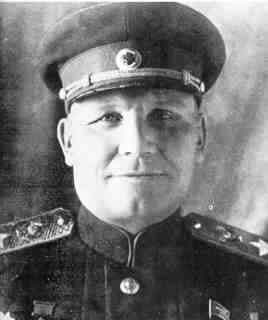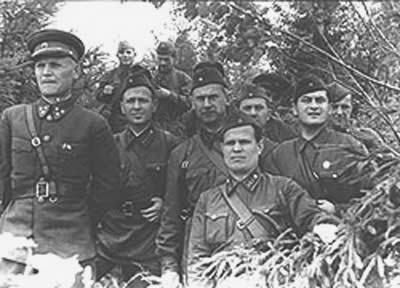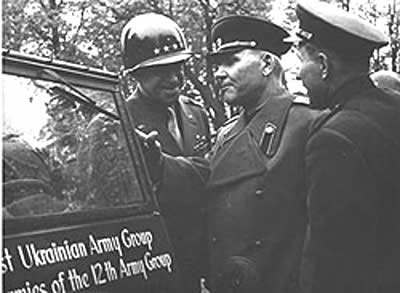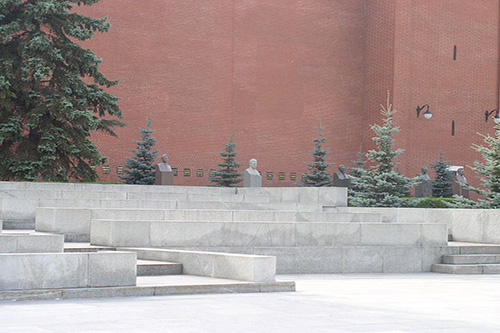Ivan Stepanovich Konev was born December 28, 1897 in Lodeino, the son of an agricultural worker who was also engaged in trade. During his youth, Konev worked the land of his parents.
In 1916, Konev was called up for compulsory military service in the Czarist army. Serving in an infantry battalion he fought against the Germans during World War One. Dissatisfaction in the Czarist army was high and Konev played an important role in organizing resistance agaianst the Czar. In 1917, the Czarist army was disbanded and Konev joined the Red Army where he was involved in organization.
He was named Commissioner of the Nikopol district where he was involved in the establishment of the so called Red Gardists. In 1919 he was transferred to the Far East to fight against the White Army during the bloody civil war. He served in the artillery of 3rd Army. He was appointed Commissar of Armored Train No. 102 for his exceptional services. The unit saw action in Ufa, Chelyabinsk and Omsk against units of the White Army commanded by Koltshak. In 1922, Konev was added to the military staff of the Soviet republic in the Far East.
Following the civil war, Konev was appointed Commissar of the 17th corps Marines and subsequently of the 17th Fusileers division in the Far East. In 1924, the division was transferred to Moscow where he met Kliment E. Voroshilov. He was impressed by Konev’s achievements and sent him to the military academy. Meanwhile, Konev had met a woman with whom he had two children who died at a young age though.
In 1926, Konev graduated from Frunze Military Academy in Moscow. He continued his study at the same academy and in 1934 he was given command of a fusileers division. Konev escaped Stalin’s cleansing of the military top but due to the changes in command, he was transferred to various divisions and served in various military districts. In July 1938, he was appointed corps commander and in 1939 he served in the 2nd Red Banner Army.
After the Germans had invaded the Soviet Union on June 22nd , 1941, Konev was put in command of 19th Army a few days later. 19th Army was deployed in the region around Vitebsk, closing the gap that had been created by the encirclements of Byalisatok and Minsk. He was involved in taking position on a defensive line along the River Dniepr. The battle of Smolensk was next where Konev’s 19th Army launched a series of counter attacks on Heinz Guderian’s 2. Panzerdivision and achieved some small successes. Konev was promoted to Colonel general for his services in the battle of Smolensk and on September 10, he took over command of the Western Front from Semyon K. Timoshenko. Konev was tasked with halting Operation Taifun to prevent Moscow from falling into enemy hands. The Western Front was surrounded though and after a month, Konev was replaced by Georgi Zhukov. At that moment, Konev and Zhukov turned into rivals. Konev did not have to remain idle for very long. He was given command of the Kalinin Front and managed to halt the advance of 4. Panzerdivision commanded by Hoepner.
Konev and his Kalinin Front were involved in the counter offensive near Moscow in December. He succeeded in liberating Kalinin but in the subsequent winter offensive, he failed to destroy the German positions at Rzhev. In August 1942, Konev was given command of the Western Front.
On November 25, the Western Front launched Operation Mars, intended to drive Heeresgruppe Mitte out of the region around Rzhev. Contrary to the offensive against 6. Armee in Stalingrad (Operation Uranus), Mars ended in disaster; the Red Army suffered 500,000 casualties.
In March 1943, Konev was given command of the Northwestern Front. On the eve of the battle of Kursk in June 1943, Konev was put in charge of the Steppe Front which was kept in reserve. After the failure of the German offensive, Konev opened a massive counter-attack with his Steppe Front. In 1943, Konev became a successful commander after all.
At the turn of 1943, Konev and his 2nd Ukranian Front (the former Steppe Front) were responsible for encircling a large German formation near Korsu, also known as the battle for Cherkassy. On February 20th , 1944, Konev was finally appointed Marshal of the Soviet Union for the successful achievements of his 2nd Ukranian Front.
On March 5, 1944 Konev, now commander of the 1st Ukrainian Front, launched a new offensive, striking all the way to the eastern border of Romenia. Thereafter, 1st Ukranian was involved in the drive from the Weichsel to the Oder and the capture of Pommerania and Silezia, creating an ideal starting position for the capture of Berlin. Stalin fueled the rivalry between Konev and Zhukov by turning the drive to Berlin into a race (which caused a lot of unnecessary losses) between the 1st Ukranian Front and Zhukov’s 1st Byelorussian Front. When Konev’s spearheads stood only 200 yards from the Reichstag, Stalin decided the building should be captured by Zhukov’s units. Following Stalin’s decision, 1st Ukranian was responsible for the libaration of Prague.
After having defeated Nazi Germany, Konev was given command of the Soviet armies of occupation in Hungary. In 1947, Konev and his second wife had a daughter who still works (written in 2003) at the Institute of Military History in Moscow. In 1950, Konev was named inspector of armaments of the Red Army and the same time deputy Secretary of Defense until he joined the Central Committee of the Soviet Union in 1952.
After Stalin’s death, Konev remained on the Central Committee. During the deStalinization, initiated by Chruschev, Konev was named chairman of the committee responsible for the trial against Beria, the former chief of the NKVD and responsible for millions of victims. The committee sentenced Beria to death. From 1955 onwards, Konev was supreme commander of the Warsaw Pact forces. In this capacity, he was responsible for quelling the uprising in Hungary in 1956. As a result of the increased tensions with the West, Konev took command of the Soviet forces in East-Germany in 1960.
Konev retired in 1962 and started writing his memoires which were published in 1972. Marshal Konev died May 21, 1973 in Moscow.
Konev is known as the most successful Soviet commander of World War Two after Marshal Zhukov. Konev received a multitude of military decorations, both Soviet and non-Soviet. He was awarded the Order of Lenin seven times, the Order of the October Revolution, the Order of the Red Banner three times, the Order of Suvurov and the Order of Kutuzov twice, the Order of the Red Star and many other decorations. Konev was also awarded foreign decorations such as Finnish and British.
Definitielijst
- Heeresgruppe
- The largest German ground formation and was directly subordinate to the OKH. Mainly consisting of a number of “Armeen” with few directly subordinate other units. A Heeresgruppe operated in a large area and could number several 100,000 men.
- infantry
- Foot soldiers of a given army.
- Marshal
- Highest military rank, Army commander.
- Nazi
- Abbreviation of a national socialist.
- offensive
- Attack on a smaller or larger scale.
- Red Army
- Army of the Soviet Union.
- resistance
- Resistance against the enemy. Often also with armed resources.
- Revolution
- Usually sudden and violent reversal of existing (political) the political set-up and situations.
- Soviet republic
- Regime based on the principle of the council system. Selected representatives have direct executive power. Regime was established after World War 1, also for some time in Bavaria and Hungary.
- Soviet Union
- Soviet Russia, alternative name for the USSR.
Images
Information
- Article by:
- Tom Notten
- Translated by:
- Arnold Palthe
- Published on:
- 19-01-2025
- Feedback?
- Send it!







